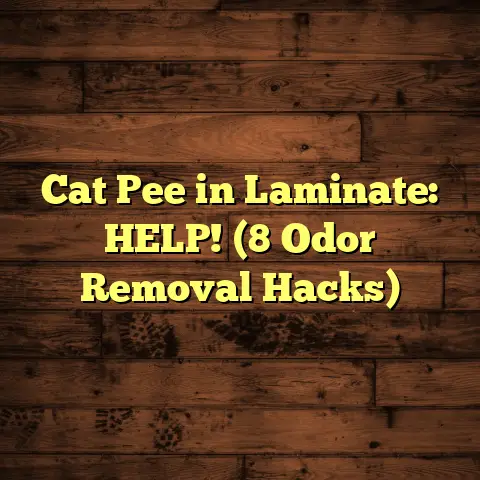Carpet On Concrete Basement? (3 Mold Risks!)
“I thought laying carpet in our basement would make it feel more like home, but I never expected to find mold creeping up the walls just a few months later.” – Sarah J., Homeowner.
Sound familiar? I hear stories like Sarah’s all the time. As a flooring contractor, I’ve seen firsthand the heartache and expense that can come from choosing the wrong flooring for a concrete basement.
Carpet can seem like a cozy, budget-friendly solution, but it often leads to trouble. Let’s dive into why carpet on concrete basements can be a recipe for mold and what you can do about it.
Understanding Concrete Basements
Basements. They’re often the forgotten spaces in our homes, relegated to storage or a makeshift playroom. Most residential basements are built with concrete.
But here’s the thing about concrete: it’s porous. Think of it like a giant sponge, constantly absorbing moisture from the ground around your home.
This is because concrete is permeable.
It allows water to pass through it.
Even if you don’t see standing water, moisture vapor is always present.
Basements are also prone to specific environmental conditions: cooler temperatures, higher humidity, and often poor ventilation. These conditions are basically a mold’s dream come true!
The Appeal of Carpeting in Basements
I get it. Carpeting is appealing!
It’s soft underfoot, adds warmth, and can make a basement feel less like a dungeon. Plus, it’s often a more affordable option upfront compared to other flooring types.
According to a 2023 study by HomeAdvisor, approximately 45% of homeowners who finish their basements choose carpet as their primary flooring.
Why? Because it instantly transforms the space.
It makes it feel more inviting, more like an extension of the living area.
A finished basement can significantly impact a homeowner’s sense of well-being. It adds living space, a place for family to gather, or a retreat for relaxation.
But that cozy feeling can quickly disappear when mold starts creeping in.
Risk #1 – Moisture Intrusion
This is the big one. Concrete, as I mentioned, is porous. Ground moisture naturally wicks its way up through the concrete slab.
When you lay carpet directly on concrete, you’re essentially trapping that moisture. The carpet and its padding act like a blanket, preventing the moisture from evaporating.
What happens then? Condensation.
Think of a cold glass of water on a humid day. The same thing happens under your carpet.
Warm, moist air hits the cool concrete, and water droplets form.
This creates the perfect breeding ground for mold.
I’ve seen countless homes where homeowners were shocked to discover mold growing beneath their carpet, often after years of seemingly no issues.
One case that sticks out was a family in Ohio. They had finished their basement with carpet and noticed a musty smell after a few months.
Upon pulling up the carpet, they found extensive mold growth, requiring professional remediation and costing them thousands of dollars.
Risk #2 – Poor Ventilation
Basements are notorious for having poor ventilation. They’re often below ground level, with limited windows or air circulation.
This lack of airflow exacerbates the moisture problem. Stagnant air traps humidity, creating an environment where mold thrives.
Humidity is a key factor in mold growth. Mold spores need moisture to germinate and grow.
Without proper ventilation, the humidity levels in your basement can easily climb above 60%, which is the ideal range for mold growth.
How do you know if you have poor ventilation?
- Musty Odors: A persistent musty smell is a telltale sign.
- Condensation: Look for condensation on windows or walls.
- Visible Mold: Obvious, but sometimes it’s hidden!
- Stuffiness: Does the air feel heavy or stale?
If you notice any of these signs, it’s crucial to address the ventilation issues before even thinking about installing carpet.
Risk #3 – Inadequate Moisture Barriers
A moisture barrier is a material designed to prevent moisture from passing through it. It’s a crucial component of any flooring installation over concrete.
Think of it as a shield between your concrete slab and your flooring.
Common types of moisture barriers include:
- Polyethylene Sheets (Plastic Sheeting): This is a common and relatively inexpensive option. It’s typically a 6-mil or 10-mil thick plastic sheet laid over the concrete before installing the flooring.
- Liquid-Applied Sealants: These are paints or coatings that are applied directly to the concrete surface. They create a waterproof barrier that prevents moisture from seeping through.
- Specialized Underlayments: Some carpet padding or underlayments come with a built-in moisture barrier.
However, even with a moisture barrier, mistakes can happen:
- Skipping the Barrier Altogether: I’ve seen homeowners try to save money by skipping this step, which is a huge mistake.
- Using the Wrong Type of Barrier: Not all barriers are created equal. Using a thin plastic sheet might not be sufficient in a high-moisture environment.
- Improper Installation: If the barrier isn’t properly sealed at the seams or around the edges, moisture can still penetrate.
I remember one DIY homeowner who used a thin plastic drop cloth as a moisture barrier. It tore easily, and moisture quickly found its way through, leading to a mold problem within months.
Identification and Prevention of Mold
Okay, so how do you know if you have a mold problem?
Here are some key indicators:
- Visual Signs: Look for discoloration, staining, or fuzzy growth on the carpet, walls, or baseboards. Mold can be black, green, white, or brown.
- Musty Odors: As mentioned before, a persistent musty smell is a strong indicator of mold.
- Allergic Reactions: If you or your family members experience unexplained allergy symptoms (sneezing, coughing, itchy eyes) when in the basement, mold could be the culprit.
Before installing carpet, take these preventive measures:
- Moisture Testing: Have your concrete slab tested for moisture levels. A professional can use a moisture meter to determine if the slab is too damp for carpeting.
- Address Leaks: Fix any leaks in your foundation or plumbing.
- Improve Ventilation: Install a dehumidifier to reduce humidity levels. Consider adding exhaust fans or opening windows (when weather permits).
- Use a High-Quality Moisture Barrier: Choose the right type of barrier for your specific situation and ensure it’s properly installed.
According to the EPA, maintaining indoor humidity levels between 30-50% can help prevent mold growth.
Alternatives to Carpet in Concrete Basements
If you’re concerned about mold, there are several excellent alternatives to carpet for concrete basements:
- Luxury Vinyl Plank (LVP): This is a popular choice because it’s waterproof, durable, and comes in a variety of styles that mimic wood or tile.
- Tile: Tile is another waterproof option that’s easy to clean and maintain.
- Epoxy Coating: Epoxy coatings create a seamless, waterproof surface that’s resistant to mold and mildew.
- Rubber Flooring: Rubber flooring is a resilient and comfortable option that’s also water-resistant.
- Engineered Wood: Engineered wood is more resistant to moisture than solid hardwood.
Each of these options has its own pros and cons in terms of cost, installation, and aesthetics. However, they all offer a significant advantage over carpet when it comes to mold resistance.
| Flooring Option | Pros | Cons |
|---|---|---|
| Luxury Vinyl Plank (LVP) | Waterproof, Durable, Variety of Styles | Can feel less warm than carpet, Can be more expensive |
| Tile | Waterproof, Easy to Clean, Durable | Can feel cold, Hard to install for DIYers |
| Epoxy Coating | Seamless, Waterproof, Mold Resistant | Can be slippery when wet, Limited design options |
| Rubber Flooring | Resilient, Comfortable, Water-Resistant | Can be expensive, Limited design options |
| Engineered Wood | Resembles Hardwood, More Moisture Resistant than Solid Wood | Can be damaged by excessive moisture, More expensive than some alternatives |
Conclusion
Installing carpet on a concrete basement can be a risky proposition. Moisture intrusion, poor ventilation, and inadequate moisture barriers can all contribute to mold growth.
Understanding these risks is crucial for making informed decisions about your basement flooring.
Before you even think about laying carpet, assess your basement’s moisture levels, ventilation, and potential for leaks.
Consider alternative flooring options that are less prone to mold issues.
Don’t let the dream of a cozy basement turn into a moldy nightmare!





